Giving hope to men everywhere, Pamela Anderson is back on the market. I think that’s what caused the meltdown on the real market yesterday.
Pamela Is Available
Nov 28
We got up in the morning and took the advice of the Tourist Information guy and looked out our window first thing in the morning. We weren’t encouraged, as it was another low overcast day with light drizzle. In fact, we were kind of sick and tired of it because it made going into the mountains kind of pointless. When we ate breakfast, the TV channel with all the cameras at mountaintops showed thick fog with light snow. So we made the decision to forgo our last chance at the mountains and instead visit Lucerne. So we took a two hour train ride over the Brunig pass to Lucerne where the weather was nicer – scattered clouds, no rain or snow. The scenery along the way is spectacular: the green mountain sides towering over deep blue lakes with high waterfalls and idyllic villages nestled into the country side. The train station at Lucerne is right in the heart of the city, and it’s just a short walk to the famous Kapellbrücke — the covered bridge across the Reuss river.
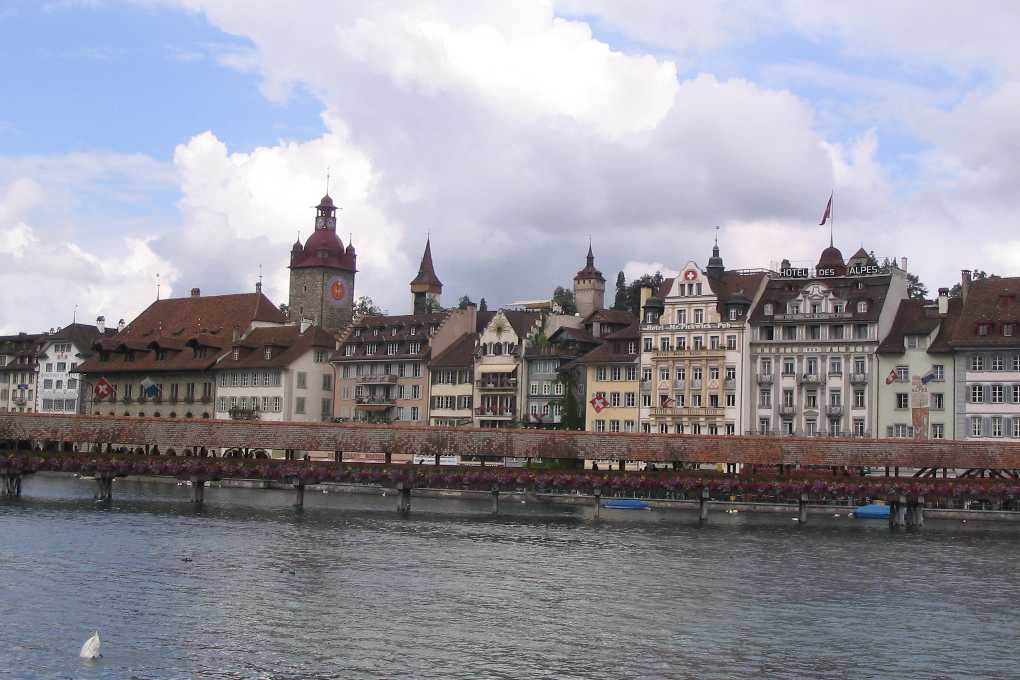 CHAPEL BRIDGE PLUS OLD TOWN EQUALS TOURIST NIRVANA
CHAPEL BRIDGE PLUS OLD TOWN EQUALS TOURIST NIRVANA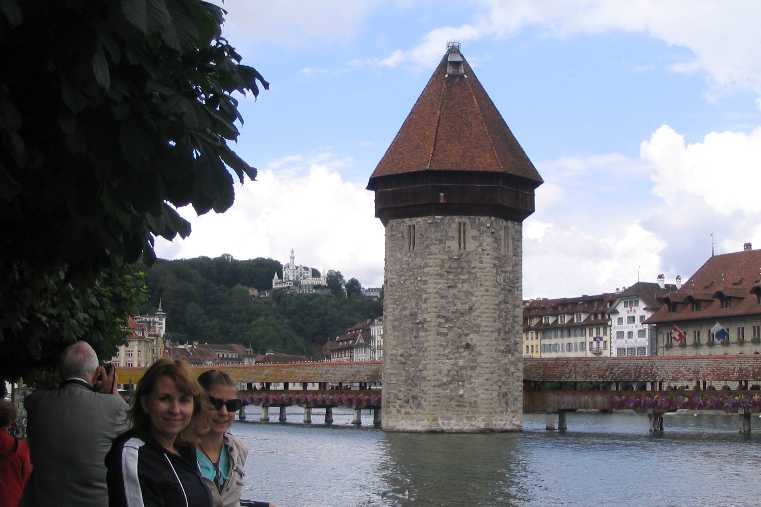
THE WATER TOWER IN THE MIDDLE OF THE BRIDGE NOW HAS A GIFT SHOP.
We crossed the bridge over to the oldest part of town and admired the paintings on the bridge along the way. Taking a break from gawking at the scenery, the women did some shopping while the men hung out, got bored, and went in search of the women who were in some extremely trendy store. Then it was time for more shopping! Eventually, even the women tired of shopping, or the male whining that accompanied it, and we moved back to admiring the town again. The funWife and I had spent a couple of nights in Lucerne back when we took our pre-kid trip to Europe, and it’s kind of neat to look back and see we took a lot of pictures at the same spots then and now. Not neat enough for me to scan the pictures in and show you the contrast, so you’ll just have to take my word for it.
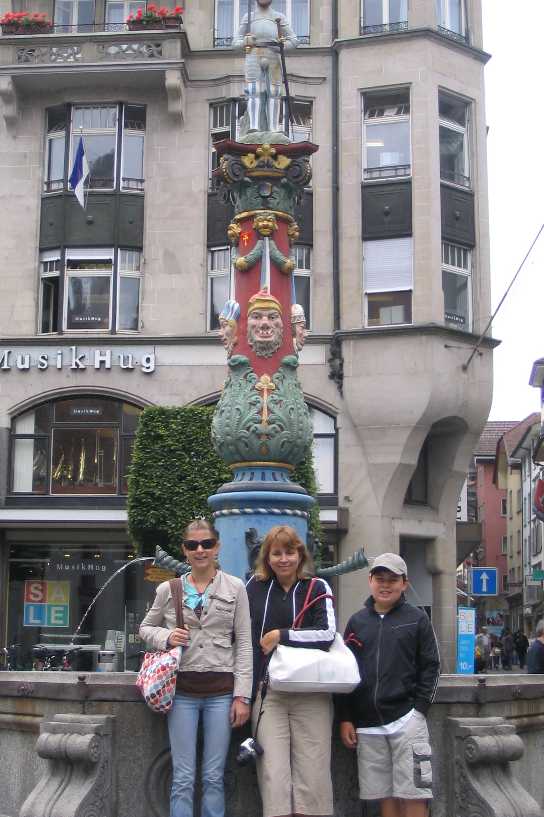
I ESPECIALLY ADMIRE THE FREE WATER AND NOT JUST ALL THE FANCY PIPES AND STUFF
I enjoy just strolling around the old cities and towns of Europe. I can go hiking in the Rockies and get almost as good scenery as the Alps, but there is nothing in America to compare to the old cities of Europe. So of course the female half of The Murphy Family wanted to celebrate the architectural glories of old Europe by shopping. The male half decided to sit that out, and did so alongside the river running through Lucerne with one studying the ornamentation of the nearby buildings in detail while taking too many pictures and the other just sitting there. Eventually the two genders rejoined and we crossed the river Reuss again, this time over the Spreuerbrücke. Where the chapel bridge has (mostly happy) paintings depicting the history of Lucerne, the mill bridge has a series of paintings titled Dance of Death so you can imagine the contrast. Thankfully, while the paintings depict death meeting people of all walks of life, not one of them has death meeting a tourist.
Sometimes you just get lucky, and this was one of them. I wanted to go to the history museum, and the Fruit of the Murphy Loins wound up enjoying it. It is the original mathom house, a hoard of objects collected over the centuries and mostly displayed in no particular order. There were the suits of armor and the collection of medieval weapons I was looking for, but cheek by jowl with them were old suitcases and sewing machines. There was a collection of Milanese shields captured from the Burgundians 800 years ago; there was a collection of Roman artifacts dating back 2 millenium (mainly trash to be quite honest, but what trash!); there were artifacts much older dating back to the earliest inhabitants; there was a toy collection from the 40s and a special display area dealing, as near as I could tell, with Swiss rock bands from the sixties. There was a coin collection I must have spent a good 15 minutes absorbed in before I realized I could spend the rest of the day investigating without seeing it all.
Most of the objects are poorly exhibited, a jumble of stuff behind steel mesh bars. But what made it fun for the Fruit were the interactive guides. When we entered, the funWife immediately asked the docent if the displays included English because she wasn’t going to plunk down her hard earned cash, even if it was vacation money, to try to puzzle out oddities labeled in French and German. No problem came the reply, we just program these hand held guides to display English, you scan the bar code on every display with them, and you can read the English text displayed about the object. So we had fun with them from the start, and when we got all the way to the top of the Arsenal (the museum is located in the old city arsenal), the Fruit discovered the guides also were programed for treasure hunts and similar games. This allowed the fearless leaders to caucus comfortably in comfy chairs and plan without interruption.
Since my choice of the History Museum had gone over so well, there were no grumbles when we set out to walk along the old city walls. So it was back over the bridge and a walk along the river to the wall. The tower closest to the river was closed, so it was up the big hill to the next tower. The scene was now bucolic; on the outside of the wall, we left the hustle and bustle of the city behind, and instead stood on a verdant hillside, with cows placidly grazing inside the electric fence. I discovered it was electrified with I put my hand on it as I climbed the hill and got a thrilling tingle. Good thing I didn’t touch two wires. And that’s a couple of things I like about Europe – no warning signs, you’re just expected to watch out for yourself, and you can stand in a field in the middle of a great city and admire a herd that has grazed in that field for, what, going on a millennium! We were there in summer and the climb was hot and tiring; the field itself looked a bit tuckered out and waiting for cooler days, but you should see the spot in glorious springwhen everything is fresh and new.
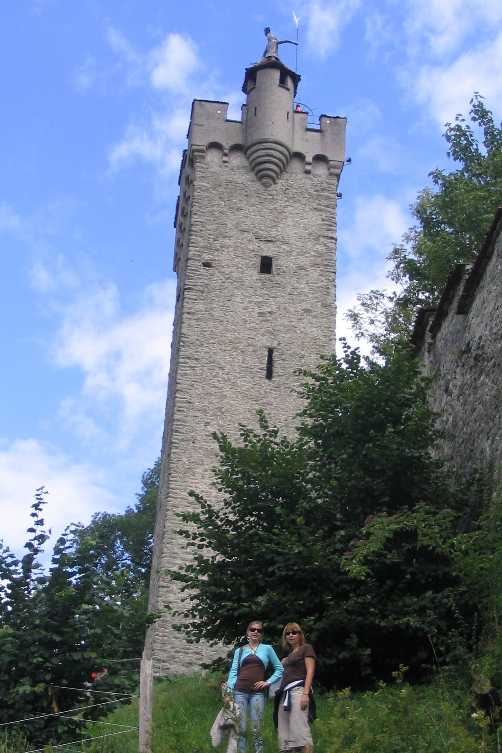
“COME ON, OLD MAN” IS NOT PARTICULARLY INSPIRING
Eventually, and with much panting, we made it to the top of the hill and the base of the tower which is open to the public. The Fearless Leaders briefly conferred and handed over the cameras to the Fruit so that they could take them to the top and make a record of the trip. We had climbed every tower in every castle we visited; we had climbed up and down the hillside Lausanne was built on; at this point of the vacation, we simply decided this far and no farther. Plus there was a park bench at the base of the tower and we didn’t want it to go to waste. So with admonishments to “Take Your Time!” still ringing in their ears, the Fruit made the climb to the top and took some outstanding photos.
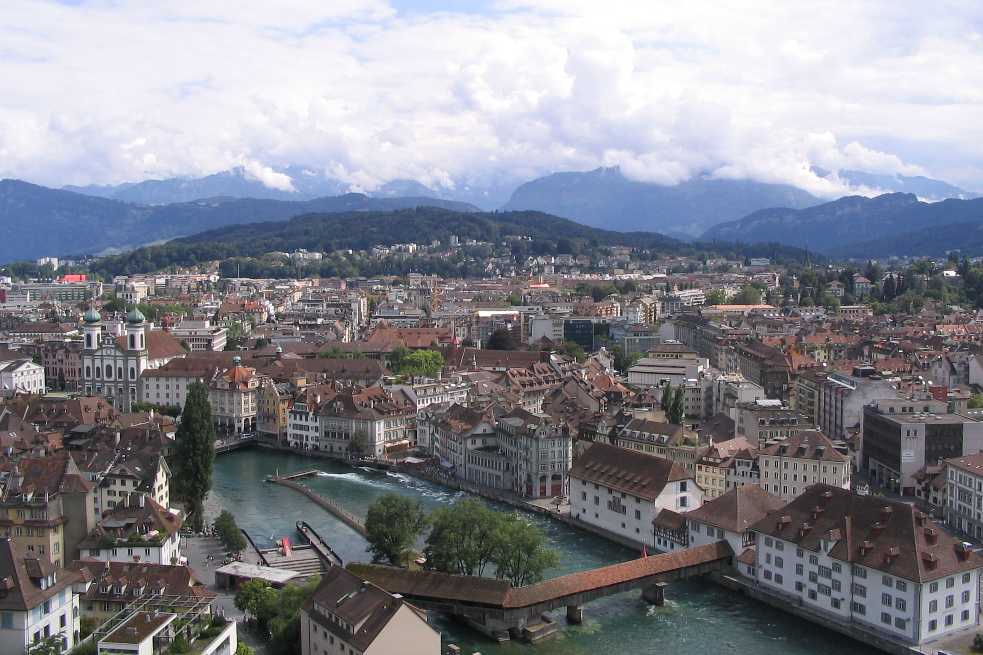
VIEW FROM LUCERNE CITY WALL
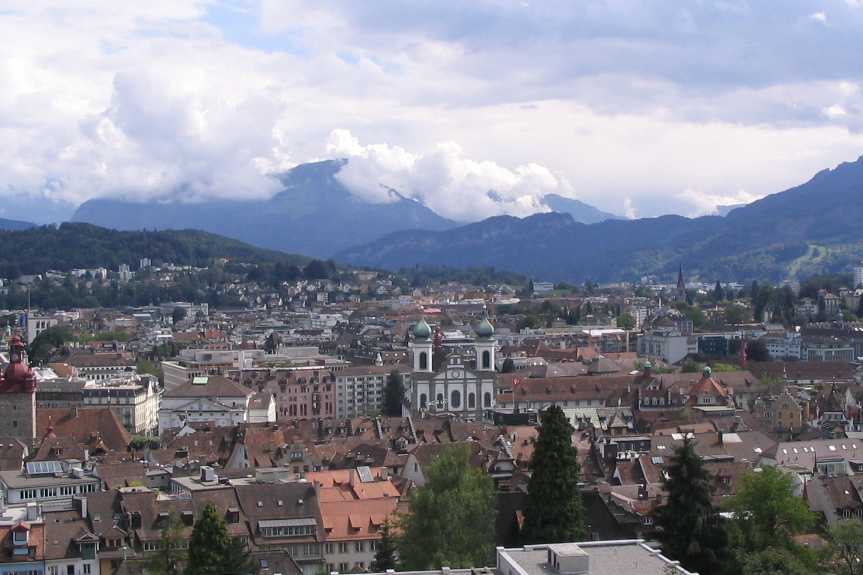
ANOTHER VIEW FROM LUCERNE CITY WALL
Eventually the Fruit returned and we continued along the wall. Past the next tower we came to tennis courts blocking the way, so we had to enter the third tower along, but we didn’t come out the other side. No, we climbed up to the top of the wall and continued our walk there. This was about the maximum excitement I could take (have I mentioned I have heightaphobia?) but the choice was to give up or continue on. I admit I wondered how many watchman were lost in adverse conditions from the top of the wall, which had the original parapet on the outside and a modern handrail on the inside. Just when I was comfortable way up there, the wall started down hill and took my confidence with it. Passing people coming the other way was torture as I had to get all the way over against the insignificant handrail, and when the rest of the Murphy Family went up in another tower I had to duck in and wait it out in the enclosed space. Still, the view was great and eventually we came to end of the wall and the stairs down. I was glad I got to walk on top of the wall and I was glad to get down.
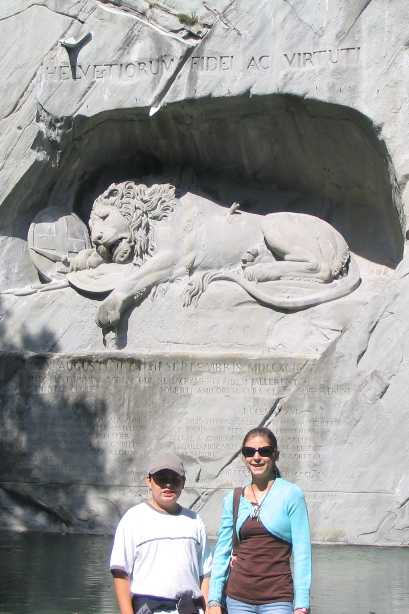
WOULD THAT ALL SUCH LOYALTY AND BRAVERY WERE HONORED
We set off for the Löwendenkmal or Lion Monument, dedicated to the Swiss guards who died in at Tuileries Palace rather than stand aside during the French Revolution. Swiss mercenaries were double good – they fought well and they stayed bought. We didn’t have a detailed map but we found our way there with our usual skill at dead reckoning and attention to concentrations of tourist buses. The monument itself is quite affecting and worth the trip.

THAT’S NO MOVIE STAR, THAT’S MY DAUGHTER
Time was beginning to press since the trains leaving for Interlaken were two hours apart so we skipped the glacier village and the panorama that were nearby and instead made our way to The Hofkirche (Abbey Court Church). Our last time in Lucerne we only saw the outside, and I wanted to see the inside. By this time we were all tired and the rest of the family clearly decided that humoring me would be course of action that let us plunk our butts down on the train the fastest. I could spend hours just recounting the glories of the entrance, but instead I’m just providing a picture of the doors with another work of art. Believe me, the entire front of the church is exquisite, and I have a whole series of pictures of the entrance that I will look at and get all warm and glowy on the inside, but then the inside is also another stunning work of art. We had enough time to devote to seeing the church, but no more, so after we satiated ourselves on beauty, we hustled back to the train station so we could make a visit to the McClean (the cleanest public restroom, and the most expensive, I’ve ever peed in) and then board our train for the ride back to Interlaken.
We wanted to make our last night a good one, and so on the way back from the train station we would stop at each restaurant, read the menu, discuss if there was something there all four of us wanted to eat. We finally settled on one restaurant, Des Alpes, but after a long wait for any service, we left and started the process all over. One thing about European restaurants – dogs are welcomed, even encouraged. We were a bit quicker about deciding on the next place, and so we had a fabulous meal at the Petit Casino. I don’t know that Fruit of the Murphy Loins had eaten at such an elegant restaurant before, and all I can say is kids, hope you liked it because I doubt you’ll ever eat at such an elegant restaurant with me again.
Quotes for a New Father
Nov 23
A co-worker (OK, an employee of one of my clients) had a son this week and e-mailed a JPEG of his newborn child–what did people do before digital cameras?–so I sent him these quotes that I thought I would also share with the dozen readers of this blog:
“One of the most important things to remember about infant care is: never change diapers in mid-stream.”
Don Marquis“All is pattern, all life, be we can’t always see the pattern when we are part of it.”
Belva Plain“Many men can make a fortune but very few can build a family. ”
J. S. Bryan“Life is full of miracles, but they are not always the ones that we pray for. ”
Eve Arden“Courage is the capacity to confront what can be imagined.”
Leo Rosten
The View From The Other Side
Nov 16
Here’s one foreigner not whooping it up over the Democrats victory:
Smart Irish policymakers – several key civil servants, a few farsighted elected pols like Mary Harney, Charlie McCreevy, Bertie and Brian Cowen, and an unofficial cadre of advisers from the private sector acting for the good of the country – realised in the late 90s that for a small open island economy to prosper it would need something more than cheap wages, Guinness and the craic.So they focused on persuading big technology and pharmaceutical companies to move their intellectual property here. In 1998, the Irish corporate tax rate was slashed from 32% to 12.5%, still among the five lowest in the world. The US federal corporate tax rate is 35%.
In 2004, Ireland simply eliminated the 9% tax on the sale or transfer of intellectual property and launched an R&D tax credit. Microsoft was among the first takers. In 2005 the Wall Street Journal revealed that a little company called Round Island One had become Ireland’s biggest taxpayer. Round Island One is a brass-plate office set up in 2001 – a subsidiary of Microsoft. It booked profits of more than $9Billion in 2004. It paid $300million in taxes to the Irish exchequer.
What happens when Charlie Rangle and company have their way and make sure “American” firms pay taxes to America? Maybe not so good for my ancestral sod.
Hat tip to Eamonn Fitzgerald
Torpedoes Versus Mines
Nov 16
Strategy page has an interesting article on naval mines.
But I was bugged a bit by these paragraphs:
Naval mines achieved several striking successes during World War II. In the Pacific, naval mines proved more destructive to the Japanese war effort than the atom bombs. During a 10 week period between April and August 1945, 12,000 mines were delivered by American bombers. These destroyed 1,250,000 tons of Japanese shipping (670 ships hit, 431 destroyed). That’s 18 mines for each ship hit. The Americans had air superiority, so losses during these 1,500 missions amounted to only 15 planes, most of them to accidents. Had these missions been flown against opposition, losses would have been between 30 and 60 aircraft, plus similar losses to their fighter escorts.
A conventional submarine campaign was also waged against Japanese shipping. Comparisons to the mine campaign are interesting. A hundred submarines were involved in a campaign that ran for 45 months from December, 1941 to August, 1945. Some 4.8 million tons of enemy shipping was sunk. For every US submarine sailor lost using submarine launched torpedoes, 560 tons of enemy ships were sunk. During the mine campaign, 3,500 tons were sunk for each US fatality. On a cost basis, the difference was equally stark. Counting the cost of lost mine laying aircraft (B- 29’s at $500,000 each) or torpedo armed submarine ($5 million each), we find that each ton of sunk shipping cost six dollars when using mines and fifty-five dollars when using submarines. These data was classified as secret until the 1970s. It indicates that mines might have been more effective than torpedoes even if the mines were delivered by submarine.
What bugs me is comparing apples and oranges here. The time frames are wildly divergent, and the submarine effort in 1941 & 1942 was nothing like the effort in 1945. There were no 100 submarines, and they were technically far inferior to the later boats, just as the B-29’s of 1945 was superior to the B-17s of 1942. For instance, American submarine losses in 1942 were 6 (when submarines were often used to try to stop Japanese fleet movements), while in 1945 they were 7 (when submarines were used almost exclusively for sinking Japanese shipping) – care to guess the difference in Japanese tonnage sunk in those two years? Care to guess how many sub losses in 1942 were from simply running aground? And given the problems with American torpedos up until mid 1943 (they didn’t explode) including this time period is especially faulty. Why not compare the results of the two methods over the same time period?
The best point is the one about submarines delivering mines, since submarines could go places earlier in the war that airplanes had no hope of doing – like Japan’s inland sea or even coastal areas. Would we have been better off using mines then instead of torpedos? Good question.
Full disclosure – my father served aboard a submarine in the pacific theater during WW II.
Life is busy busy busy these days. Just not with blogging.
But don’t worry, Tim’s got a great post about how American schools are failing to teach math – and I have to agree from the experience of my own two lovable fruit whose elementary school math program was english in drag and suffered from the whole ‘here’s a buch of ways of doing math if you ever, someday but not in this math class, actually do math instead of just talk it to death” approach.
Lemonade
Nov 14
Sometimes I sits and thinks, and sometimes I just sits.
I never thought the Episcopalians had this much fire in the belly until I met Chris.
Coming to a Hospital Near You Soon. Or not.
Charles has resurfaced. Welcome back.
Reading time, just one minute.
It’s amazing what a big bubble will do for your self esteem I thought I was Mr. Super Investor (bet you did too).
Here’s important reading for all of us with adolescents: Risk and Rationality in Adolescent Decision Making.
Is it a good idea to swim with sharks? Is it smart to drink a bottle of Drano? What about setting your hair on fire — is that a good thing to do?People of all ages are able to give the correct answer (it’s “no,” in case you were wondering) to each of these questions. But adolescents take just a little bit longer (about 170 milliseconds longer, to be exact) to arrive at the right answer than adults do. That split second may contain a world of insight into how adolescents tick — and how they tick differently from adults.
…
It is often believed that adolescents think they are immortal, just plain invulnerable to life’s slings and arrows. This notion is often used to explain why young people are liable to drive fast, have unprotected sex, smoke, or take drugs — risks that adults are somewhat more likely to shy away from.Research shows that adolescents do exhibit an optimistic bias — that is, a tendency to underestimate their own risks relative to their peers. But this bias turns out to be no more prevalent in adolescents than in grownups; adults commit the very same fallacy in their reasoning. And actually, studies on perception of risks by children, adolescents, and adults show that young people tend to overestimate their risks for a range of hazards (including car accidents and sexually transmitted diseases such as HIV/AIDS), both in absolute terms (i.e., as compared with actual risks) and relative to adults. Their estimation of vulnerability declines rather than increases with age.
So why do adolescents take risks? Decision research answers this with another counterintuitive finding: Adolescents make the risky judgments they do because they are actually, in some ways, more rational than adults. Grownups tend to quickly and intuitively grasp that certain risks (e.g., drunk driving, unprotected sex, and most anything involving sharks) are just too great to be worth thinking about, so they don’t proceed down the “slippery slope” of actually calculating the odds. Adolescents, on the other hand, actually take the time to weigh risks and benefits — possibly deciding that the latter outweigh the former.
So adolescents engage in just the sort of calculations — trading off risks against benefits — that economists wish that all people would make. But economists notwithstanding, research is showing more and more that a faster, more intuitive, less strictly “rational” form of reasoning that comes with increased experience can often be more effective. Mature or experienced decision makers (e.g., experienced vs. less experience physicians) rely more on fuzzy reasoning, processing situations and problems as “gists” rather than weighing multiple factors and evidence. This leads to better decisions, not only in everyday life but also in places like emergency rooms where the speed and quality of risky decisions are critical.
These counterintuitive conclusions about the decision-making processes of young people have major implications for how to intervene to help steer them in the right direction. For example, interventions aimed at reducing smoking or unprotected sex in young people by presenting accurate risk data on lung-cancer and HIV may actually backfire if young people overestimate their risks anyway. Instead, interventions should focus on facilitating the development of mature, gist-based thinking in which dangerous risks are categorically avoided rather than weighed in a rational, deliberative way.
Just another example of the triumph of experience over reason.
I guess you can throw those books out that tell you to calmly reason with your child to get them to see the error of their ways and go back to “Because I said so!”
It looks like McCoy wins the argument — who needs a Spock to calculate the odds of almost anything when you can imploy McCoy’s fuzzy logic so much faster to arrive at the correct answer.
Maybe its a good thing many teenagers factor in their parent’s natural overreaction when deciding whether to engage in risky behavior. So parents, let’s up the ante and overreact to just about everything. Put your thumbs firmly on the scale of right behavior.
It supports my personal study of non-adolescent reasoning, namely, that adults simply do what they think is right and engage in reason only after the fact when pressed to provide reasons for what they did.
Sienna Miller Available
Nov 13
Sienna Miller is back on the market. I’m letting you know as just another part of the total information awareness package here at Funmurphys.
Peggy Noonan writes very movingly in today’s Opinion Journal on Concession Stands. She addresses the need for national unity in winning the war against those who are committed to our destruction (emphasis added):
We are in a 30-year war. It is no good for it to be led by, identified with, one party. It is no good for half the nation to feel estranged from its government’s decisions. It’s no good for us to be broken up more than a nation normally would be. And straight down the middle is a bad break, the kind that snaps.
[…]
This is the age we live in: One day in the future either New York or Washington or both will be hit again, hard. It will be more deadly than 9/11. And on that day, those who experience it, who see the flash or hear the alarms, will try to help each other.
[…]
There are rogue states and rogue actors, there are forces and nations aligned against us, and they have nukes and other weapons of mass destruction, and some of them are mad. Know this. Walk to work each day knowing it, not in a pointlessly fearful way but in a spirit of “What can I do to make it better?”What can you do in two years? The common wisdom says not much. But here’s a governing attitude: First things first.
Do all you can to keep America as safe as possible as long as possible. Make sure she’s able to take a bad blow, a bad series of them. Much flows from this first thing, many subsets. Here is only one: Strengthen and modernize our electrical grid. When the bad thing comes we will need to be able to make contact with each other to survive together. Congress has ignored this for years.
Make America in the world as safe as possible by tending to and building our friendships in the world, by causing no unnecessary friction, by adding whatever possible and necessary emollients. In your approach to foreign affairs, rewrite Teddy Roosevelt: Speak softly, walk softly, and carry a big stick.
[..]
Those to me are the two big things. Much follows them, and flows from them. But to make some progress on these two things in the next two years would be breathtaking.